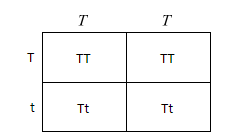
A flower with a Tt genotype is cross-pollinated by TT pollens. What will the genotypes of the resulting endosperm and embryo, respectively, be?
A.TTT,(TT+tt)
B.TTT(TTT+TTt)TT
C.TTt,Tt
D.TTt(TT+Tt)
Answer
561.3k+ views
Hint:Double fertilization is the process wherein both the egg and the polar nuclei are fertilized by two individual pollen. The fertilized egg becomes the embryo whereas the fused polar nuclei become the endosperm. So when crossing pollen of TT with an egg of Tt, we get either TT or Tt, and the fusion of the polar nuclei, one having T and the other having t, when fused with pollen of TT, will result in a genotype TTt
Complete step by step answer:There are eight different cells present with the ovule of a flowering plant, of which 3 are antipodal cells, 1 egg cell, 2 polar cells, and 2 synergids. The antipodal cells provide nourishment to the developing embryo and the synergids play an important role in pollen tube formation and guidance. When two pollens enter the ovule, one fertilizes the egg and the other fertilizes the polar nuclei cells. This is known as double fertilization.
The fusion of haploid pollen of genotype TT with that of a haploid egg of genotype Tt would give offerings of the genotype of either TT or Tt which would become the embryo.

Now the two polar nuclei are also haploid cells each containing one allele of the flower’s genotype, which would be T and t. Now if haploid pollen of genotype TT fuses with the polar nuclei we would have a fused triploid cell of genotype TTt. Thus, the fused polar nuclei which later develop into the endosperm will have a genotype of TTt.
Therefore, the correct answer is option D, TTt(TT+Tt).
Note:Double fertilization is the process where both the egg and the polar nuclei are fertilized.
The fertilized egg becomes the embryo and the fused polar nuclei become the endosperm.
The genotype of the polar nuclei will have three alleles and that cell is known as a triploid cell.
Complete step by step answer:There are eight different cells present with the ovule of a flowering plant, of which 3 are antipodal cells, 1 egg cell, 2 polar cells, and 2 synergids. The antipodal cells provide nourishment to the developing embryo and the synergids play an important role in pollen tube formation and guidance. When two pollens enter the ovule, one fertilizes the egg and the other fertilizes the polar nuclei cells. This is known as double fertilization.
The fusion of haploid pollen of genotype TT with that of a haploid egg of genotype Tt would give offerings of the genotype of either TT or Tt which would become the embryo.

Now the two polar nuclei are also haploid cells each containing one allele of the flower’s genotype, which would be T and t. Now if haploid pollen of genotype TT fuses with the polar nuclei we would have a fused triploid cell of genotype TTt. Thus, the fused polar nuclei which later develop into the endosperm will have a genotype of TTt.
Therefore, the correct answer is option D, TTt(TT+Tt).
Note:Double fertilization is the process where both the egg and the polar nuclei are fertilized.
The fertilized egg becomes the embryo and the fused polar nuclei become the endosperm.
The genotype of the polar nuclei will have three alleles and that cell is known as a triploid cell.
Recently Updated Pages
Master Class 12 Business Studies: Engaging Questions & Answers for Success

Master Class 12 Economics: Engaging Questions & Answers for Success

Master Class 12 English: Engaging Questions & Answers for Success

Master Class 12 Maths: Engaging Questions & Answers for Success

Master Class 12 Social Science: Engaging Questions & Answers for Success

Master Class 12 Chemistry: Engaging Questions & Answers for Success

Trending doubts
What are the major means of transport Explain each class 12 social science CBSE

Which are the Top 10 Largest Countries of the World?

Draw a labelled sketch of the human eye class 12 physics CBSE

Explain sex determination in humans with line diag class 12 biology CBSE

The pH of the pancreatic juice is A 64 B 86 C 120 D class 12 biology CBSE

Explain sex determination in humans with the help of class 12 biology CBSE




